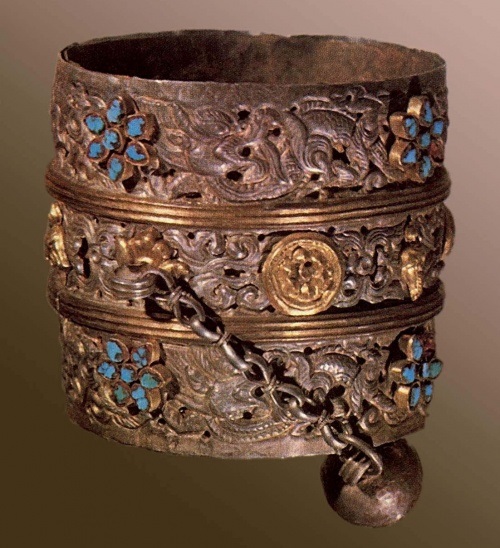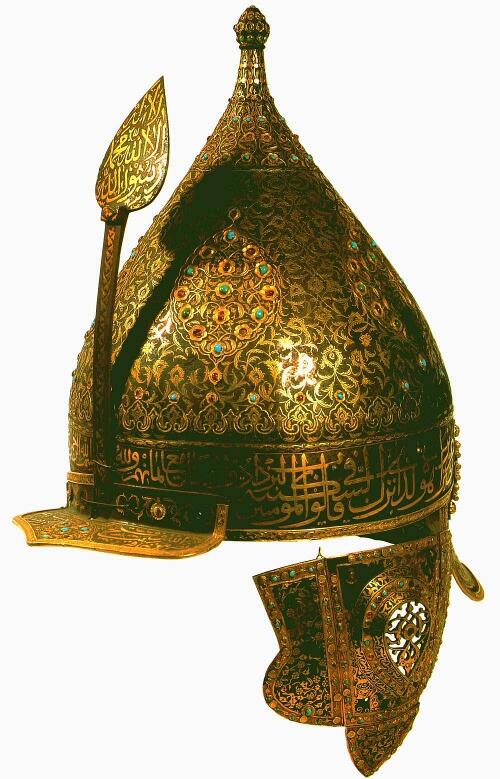Islamic East Jewelled Arts

Binding of the Quran with emerald. The beginning of the 19th century. Gold, diamonds, emeralds. The Topkapı Palace Museum, Istanbul, Turkey. Islamic East Jewelled Arts
Islamic East Jewelled Arts
Worked out by the peoples of the Middle East during the Middle Ages, based on the cultural traditions of the area and the principles of Islam. From the beginning, the art of Muslim countries showed originality, associated with the ethnic culture. However, Islamization, covering all the space developed common principles, which became mandatory for all parts of the Muslim world.
In fact, Islam forbids images of living beings, first of all, people. Meanwhile, in Iran, where even before the arrival of Islam was a tradition of depicting scenes from the life of the rulers in miniature, wall painting, and carpet weaving, the ban was never total.
During the Mamluk era (1250-1390) glass objects were decorated in the style of Naskh inscriptions and floral ornaments. At the same time in Egypt and Syria appear vessels “flavors”. Narrow neck allows to produce liquid droplets and flavors not to spill the precious moisture in the fall. Especially interesting are the vessels of opaque glass with feathery pattern.
Crusaders literally hunted for eastern objects made of glass. In particular, they took out lamps with which mosques were equipped, and gave them as gifts to Christian monasteries and churches. It should be noted that during this period Europeans in the light of their homes (and even streets) significantly lagged behind the Arabs.
Golden dagger. The first half of the 18th century. Gold, emeralds, gemstones. Topkapi Palace Museum, Istanbul, Turkey. On the hilt of a dagger mounted a large octagonal emerald, hiding tiny clock English work. Made as a gift to Nadir Shah of Persia. After his death, was returned to the Sultan’s palace.
In Damascus, then in Andalusia began to make the famous Damascus and Toledo blades, the secret of making which is kept in the strictest confidence. High quality Damascus or Toledo Damascus steel is achieved through strict adherence to the recipe: strips of iron and steel (cheap varieties) or strips of different steel grades (in the best varieties) welded at a certain temperature. Toledo Blade was in great demand in Europe. Stored in the Madrid museum “Escorial” saber Abdullah al-Sahir, an approximate one of the last Arab rulers in Spain (14 in.), A gold-plated hilt with amazing inlaid with ivory.
Helmet. Mid-16th century. Iron, turquoise, rubies; Gold notch, black enamel. Topkapi Palace Museum, Istanbul, Turkey. On the helmet exquisite decorative lettering inscribed with verses from the Koran, praising Allah.
Smelting technology is constantly improving. Invasion of the Crusaders in the Middle East forced gunsmiths work harder. As a result, the art of smelting and processing of weapons-grade metal has received a special development. Thus, in the 15th century in the State Aq Qoyunlu (“White Sheep” – Confederation of Turkmen tribes centered in Diyarbakr; rule in Eastern Anatolia and Azerbaijan in 1378-1508) produced magnificent helmets for soldiers. Judging from the samples, they were put on a turban (hence their name Tyurbane – “turban hat”). Made of steel, decorated and engraved with silver, while the helmet itself, like an onion, had thin walls. Along the perimeter of the helmet calligraphic font applied good wishes to the owner, as well as the name of the customer.
No less decorative were medieval weapons of Turkey. Guns were usually decorated with mother of pearl in technique “Sadaf”, and to sabers and scimitars applied gold notches. Hilt decorated with beading and accents of precious stones, coral, turquoise. In the same way were decorated powder flasks. They were made of metal, leather, wood, shells and animal horns. On one of the flasks 17 century, Located in the collection of the “House of Islamic monuments” in Kuwait (a collection of the ruling house of Al-Sabah) engraved the poem by Gulistan Saadi: “The aim (of life) is to leave a remembrance of Me, for I I do not see being in eternity. ”
Well-known Russian orientalist Academician VV Bartold wrote that it was because of the contact with the Arabs, Europeans learned about the various weapons in the East after 1147, although certain types of weapons were already known from Spain, which has become a gateway through which to Europe come weapons made in the East.
With the growth and development of handicraft production, it has become almost the main occupation of the townspeople. Gunsmiths craft community lived and worked under the laws. Each newcomer was rigorously tested for fit and carefully selected from a large number of applicants. Gun crafts were under the direct supervision of the military authorities and chief Sheikh (Sheikh al-shuyuh – Arab.), Who was prescribed to control the state of arms and qualifications of masters. Until now, many of Damascus swords are called proper names of the founders of the “Dynasty” gunsmiths – Suyufi, Sayqal, Sakakini, Jawhar, Bulad.
No less valuable weapon was inlaid with gold, silver, precious stones, which were produced in Iran for the Safavid nobility. On some blades made epigraphic inscriptions – usually sayings from the Koran, which should give to the sword holder more bravity. Usually labeled on the edge of a blade with gold and silver.
The great popularity had decorative and household utensils made of metal. Rulers ordered the utensils from the best blacksmiths, so many of them had cartouche or encircling band with the name of the customer. But gradually began to produce similar products for the mass market, especially since at that time the food cooked over an open fire.
During the reign of the Mamluk in Egypt and Syria produced pitchers, bowls, boxes of sheet brass, engraved and inlaid with silver. Inscriptions, which in addition to its informational value, were the main decorative element of the time.
As a rule, they performed handwriting Soultz. In order to evenly distribute the inscription, it was terminated as a cartouche medallions – round or triangular. Simultaneously, the master also used geometric and floral pattern that filled the remaining space. Items ordered specially for Mamluk aristocracy, usually had labels listing all the epithets of the customer, as well as praise in his address.
Artisans of Cairo, Baghdad, Damascus also produced braziers for heating, trays, jugs for water vessels for other purposes, coffee pots, incense burners, lamps, candlesticks and candelabra, with which were equipped mosques and madrassas.
All researchers of Islamic art draw attention to the original jars in the shape of birds and animals. They appeared the tradition of pre-Islamic Sassanian and Sogdian art. The oldest specimens are 8-9 cc., But the tradition to give utensils animal form persisted until the 14th century. Very often these items were made in Iran, where a total ban on images of living beings never enforced. But in the 12-13 centuries similar products were made in Egypt.
Almost everywhere for decoration of metal products used embossing, engraving, inlaid with copper, gold, silver. Masters created candlesticks, jugs, vases, writing utensils, boxes for storage of the Koran, incense, which filled the entire surface of the complex patterns.
In the 13-15 centuries smiths of the Middle East have reached a high level of skill. They decorated their bronzes with finest engraving, embossing, ink, cartridges inserted with silver and gold, colored enamel and precious stones. Techniques that were used for the manufacture of metal objects varied. This casting, and toreutics: engraving, chasing, carving. Geography of origin of samples of artistic metal in museums around the world suggests that the masters of the East constantly updated their equipment, borrowing methods of ornamentation, in particular, engraving, and even forms of vessels.
A unique collection of early metal products related to 7-9 cc., is a collection of Islamic art of the Hermitage in St. Petersburg, Russia. In recent decades, museum workers of the Middle East began to actively collect antiques.
‘Brilliant of spoons merchant’ (Kasykchi). – one of the attractions of Topkapi. According to one legend, in 1774 it was bought by the Maharaja of Madras, and later the stone moved on to mother of Napoleon, and finally was sold to Turkey.
- Helmet. Mid-16th century. Iron, turquoise, rubies; Gold notch, black enamel. Topkapi Palace Museum, Istanbul, Turkey
- Precious pages. Islamic East Jewelled Arts
- Bracelet – Islamic East Jewelled Arts
- Stunning Islamic East Jewelled Arts – bracelet
- Vessel. Islamic East Jewelled Arts
- Binding of the Quran Sultan Moorabi III. The end of the 16th century. Gold, precious stones. Topkapi Palace Museum in Istanbul, Turkey
- Beautiful Islamic East Jewelled Arts
- Gorgeous Islamic East Jewelled Arts
- Pitcher (mataras) for water. The second half of the 16th century. Gold, precious stones. Topkapi Palace Museum, Istanbul, Turkey
- Throne. Islamic East Jewelled Arts
- Exquisite Islamic East Jewelled Arts
- Unique Islamic East Jewelled Arts
- Decoration. Islamic East Jewelled Arts
- Earring. Late 19th – early 20th century. Length of 7.6 cm. Silver, metal, amethyst, turquoise, glass; gilding. Russian Ethnographic Museum, St. Petersburg, Russia
- ‘Brilliant of spoons merchant’ (Kasykchi). Diamonds. 86 carat weight. Topkapi Palace Museum, Istanbul, Turkey
- Head decoration. Islamic East Jewelled Arts
- Earrings. Islamic East Jewelled Arts
- Ancient Islamic East Jewelled Arts
- Suspension. Islamic East Jewelled Arts
- Pieces of Islamic East Jewelled Arts
- Sample of Islamic East Jewelled Arts
- Bracelet Islamic East Jewelled Arts
- Details. Islamic East Jewelled Arts
- Closeup Islamic East Jewelled Arts
Islamic East Jewelled Arts
- Fabulous Islamic East Jewelled Arts
- Emerald brooch Islamic East Jewelled Arts
- Women’s decoration. Islamic East Jewelled Arts
- Large earring. Islamic East Jewelled Arts
- Massive Islamic East Jewelled Arts
- Ancient Islamic East Jewelled Arts
- Leaf earrings Islamic East Jewelled Arts
- Precious Islamic East Jewelled Arts
- 18th century. Emeralds, diamonds, pearls; red enamel. Topkapi Palace Museum, Istanbul, Turkey
- Watches Turkish work. Mid-17th century. Rubies, emeralds, turquoise. Topkapi Palace Museum, Istanbul, Turkey
- Holy Book Koran al-Karim bound in green marble, decorated with sapphires and garnets. Kazan (Russia). The Largest Printed Koran in the world
- Koran cover
- Vessel for incense. The second half of the 16th century. Gold, turquoise, precious stones; engraving, inlay. Topkapi Palace Museum, Istanbul, Turkey
liveinternet.ru/community/3299606







































